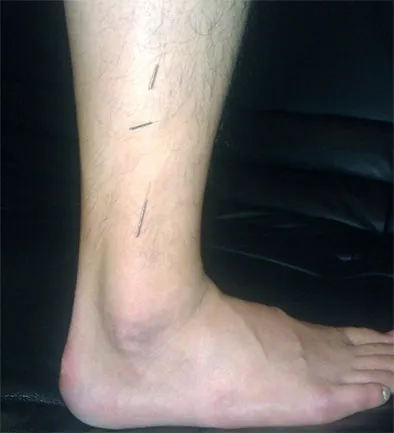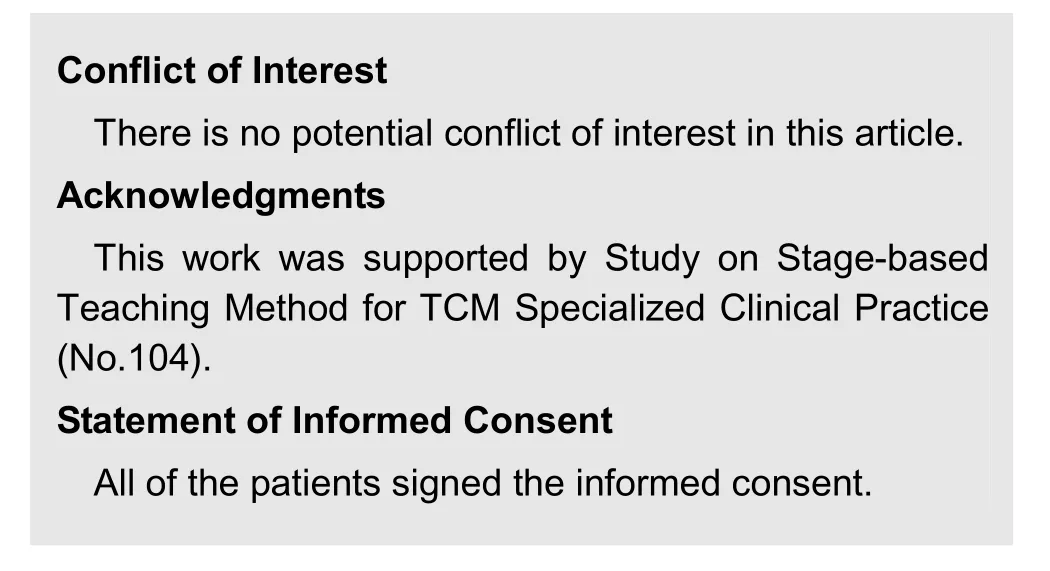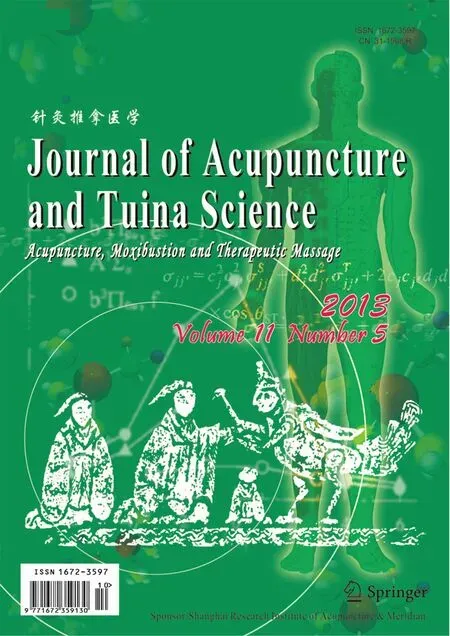Clinical Observation on Dong’s Extraordinary Points for Tinnitus Due to Cervical Spondylosis
2013-07-18ZhangShenghongWuYaochiChenJie
Zhang Sheng-hong, Wu Yao-chi, Chen Jie
1 No.6 People’s Hospital Affiliated to Shanghai Jiaotong University, Shanghai 200233, China
2 Jiading District Hospital of Traditional Chinese Medicine, Shanghai 201800, China
Clinical Observation on Dong’s Extraordinary Points for Tinnitus Due to Cervical Spondylosis
Zhang Sheng-hong1, Wu Yao-chi1, Chen Jie2
1 No.6 People’s Hospital Affiliated to Shanghai Jiaotong University, Shanghai 200233, China
2 Jiading District Hospital of Traditional Chinese Medicine, Shanghai 201800, China
Objective: To observe the clinical efficacy of Dong’s extraordinary points in treating tinnitus due to cervical spondylosis.
Methods: Totally 140 eligible subjects diagnosed with tinnitus due to cervical spondylosis were randomized into two groups, seventy in the treatment group were intervened by acupuncture at Dong’s extraordinary points; seventy in the control group were intervened by acupuncture at cervical Jiaji (EX-B 2) and distal points on limbs. Therapeutic efficacy was observed after a treatment course.
Results: The total effective rate was 95.7% in the treatment group versus 85.7% in the control group, and the difference was statistically significant (P<0.05).
Conclusion: Compared to traditional point selection, acupuncture at Dong’s extraordinary points has advantages of fewer points, less pain, faster effect, and better therapeutic efficacy.
Acupuncture Therapy; Spondylosis; Neck Pain; Tinnitus
As one type of tinnitus, cervical-spondylosis-induced tinnitus has been affecting more and more people, and most of them are desk workers. From topical inflammation and edema to accumulated fluid, dysbolism and hyperplasia may occur at late stage. We adopted Dong’s extraordinary points to treat tinnitus caused by cervical spondylosis. It’s now reported as follows.
1 Clinical Materials
1.1 Inclusion criteria
With tinnitus as the major complaint, presenting in one or both ears, intermittent or persisting, with single or complex sound, diagnosed by other hospitals or the ENT Department of our hospital; organic diseases are excluded; having a history of cervical spondylosis confirmed by X-ray or magnetic resonance imaging (MRI) test; with complete medical history and being able to finish one treatment course.
1.2 Exclusion criteria
Conductive tinnitus due to disorders in external ear, middle ear, or internal ear; objective tinnitus such as pulsatile tinnitus and myogenic tinnitus; other disorders of auditory system, such as nerve tumor and auditory neuropathy; tinnitus induced by diseases of other systems, such as psychological diseases, and diseases of hematopoietic system and endocrine system; patients with cardiocerebrovascular diseases or tumor.
1.3 General data
During Jan 2011 and Jan 2012, 140 eligible subjects were enrolled. Their age ranged 35-65 years old. The shortest disease duration was 1 week, and the longest was 20 years. The 140 subjects were randomized into a treatment group and a control group by the visiting sequence, 70 in each group. There were no significant differences in gender, age, and disease duration (P>0.05), indicating the comparability (table 1).

Table 1. General data comparison of the two groups
2 Treatment Methods
2.1 Treatment group
Major points: Wanshun points (Wanshun 1, Wanshun 2)[1], (Fig.1).

Fig.1 Wanshun points
Adjunct points: Sanchong points (Yichong, Erchong, and Sanchong), (Fig.2).

Fig.2 Sanchong points
Location: Ask the patient to take a sitting position, and locate the points on the contralateral limbs to the affected ear. Wanshun 1 is on the back of the hand, on the inferior border lateral to the metacarpal of the little finger, 1.5 cun below the wrist crease; Wanshun 2 is located 1 cun below Wanshun 1. Yichong is located 3 cun superior and 1 cun anterior to the tip of the external malleolus; Erchong is 2 cun superior to Yichong; Sanchong is 2 cun superior to Erchong.
Operation: Choose filiform needles of 0.30 mm in diameter and 40 mm in length to puncture the above acupoints perpendicularly by 0.5-1 cun. The treatment was given once every other day, 10 times as a treatment course, and the therapeutic efficacy was evaluated after a course.
2.2 Control group
Acupoints: Cervical Jiaji (EX-B 2), Fengchi (GB 20), Houxi (SI 3), and Waiguan (TE 5)[2-3].
Operation: Ask the patient to take a sitting position, and then choose filiform needles of 0.30 mm in diameter and 40 mm in length to puncture the above points. Fengchi (GB 20) should be punctured obliquely with the needle tip towards the nose by 0.5-1 cun; Waiguan (TE 5) and Houxi (SI 3) should be punctured perpendicularly by 0.5-1 cun; cervical Jiaji (EX-B 2) should be punctured perpendicularly by 1-1.5 cun. Even reinforcing-reducing manipulations were applied to the cervical points after insertion; lifting-thrusting and twisting manipulations were applied to limb points upon the arrival of qi, and the points were either tonified or reduced based on the syndrome differentiation. The needles were retained for 20 min each time and manipulated twice during the retaining. The treatment was given once every other day, 10 times as a treatment course, and the therapeutic efficacy was evaluated after a course.
3 Observation on Therapeutic Efficacy
3.1 Criteria of therapeutic efficacy
The therapeutic efficacy was evaluated by theEvaluation and Scoring Criteria of Tinnitus and the Therapeutic Effects[4].
Recovery: Tinnitus and the accompanied symptoms are gone, and no relapse is revealed in a one-month follow-up.
Improved: Tinnitus degree declines by over 1 grade.
Invalid: Tinnitus degree has no change.
Because of the rather short treatment duration, we regard the subjects with remarkable effect and improvement to be improved.
3.2 Statistical analysis
The SPSS 15.0 software was adopted for data analysis. The Chi-square was for the comparison ofratio andP<0.05 is considered to have a statistical significance.
3.3 Treatment result
After a treatment course, the total effective rate was 95.7% in the treatment group versus 85.7% in the control group, and the difference was statistically significant (P<0.05), (table 2).

Table 2. Comparison of the therapeutic efficacy (case)
4 Discussion
When treating a disease, traditional Chinese medicine (TCM) always grasps the original cause. Although tinnitus is an ear disease, its primary cause is the cervical degeneration and the subsequent compression to the nerve roots and vertebral arteries. When the vertebrobasilar artery is compressed by the cervical hyperosteogeny, the cerebral blood supply will be insufficient, leading to ischemic symptoms. As a branch of the vertebrobasilar artery, the posterior cerebral artery is the origin of the internal auditory artery, which supplies blood to the ear. The compression to vertebrobasilar artery can lead to the decrease of blood flow in the internal auditory artery and malnutrition of the ear, and there comes tinnitus[5-7]. TCM holds that this type of tinnitus is due to blood deficiency and stagnation. Besides, the kidney opens at the ear. Therefore, tinnitus due to cervical spondylosis should be treated by tonifying blood, activating the blood circulation, and benefiting the kidney[8-9].
Dong’s acupuncture is an independent school of acupuncture therapy inherited and developed by physician Dong Jing-chang. Distinct from the ordinary extraordinary points, it’s neither the Ashi points, nor the reaction points, but accumulated and summarized by physician Dong and his ancestors based on the long-term clinical practice. Dong’s acupuncture science is a huge system covering over 750 points. It’s closely associated with TCM theories, the fourteen meridians, bioholography, and nerve distribution. Sanchong points work to unblock qi stagnation and promote the blood circulation, and thus are crucial points in treating blood stagnation. Wanshun points belong to the kidney, and the kidney governs the ear[1]. Therefore Wanshun points can be used to treat ear diseases. Meanwhile, they are also at the corresponding locations of cervical vertebrae according to the holographic theory in Dong’s acupuncture. The points were selected on the healthy side according to the contralateral acupuncture theory in TCM, which is also one of the methods in Dong’s acupuncture.
Compared to the twelve ordinary meridians, Dong’s acupuncture neither adopts special manipulations, nor stickles about tonifying and reducing theories. When it’s used properly, excellent therapeutic efficacy can be achieved. It’s proved by clinical practice that Dong’s acupuncture has advantages of fewer acupoints, less pain, efficiency, and good therapeutic efficacy, and is thus worthy of promotion in clinic. To treat cervical tinnitus with Dong’s acupuncture, the whole blood and qi system is regulated, which relieves both tinnitus and cervical discomfort, treating both the original cause and the superficial manifestations.

[1] Li GZ. Taiwan Dong’s Acupuncture and Acupoints. Taipei: Zhiyuan Book Store, 1994.
[2] Shen XY. Meridians and Acupoints. Beijing: China Press of Traditional Chinese Medicine, 2003.
[3] Wang HR. Acupuncture at cervical Jiaji (EX-B 2) for 35 cases of tinnitus. Sichuan Zhongyi, 2008, 26(3): 123.
[4] Liu P, Li M. Reflection of the therapeutic evaluation of tinnitus. Zhonghua Erbi Yanhou Toujing Waike Zazhi, 2008, 43(9): 710-713.
[5] Ma ZK. Acupuncture-moxibustion plus manual manipulations for 168 cases of cervical tinnitus. Shanghai Zhenjiu Zazhi, 2009, 28(10): 599.
[6] Mo WQ, Ma XP. Introduction to Hua Xue-gui’s experience in acupuncture treatment of tinnitus and deafness. J Acupunct Tuina Sci, 2008, 6(6): 328-330.
[7] Liang H, Li YQ, Li M. Analysis of the present situation of literature on acupuncture treatment tinnitus. Shanghai Zhenjiu Zazhi, 2010, 29(12): 801-804.
[8] Zhang J, He QY. Treatment of 33 cases of nerve tinnitus by acupuncture on syndrome differentiation. J Acupunct Tuina Sci, 2006, 4(5): 310-311.
[9] He GW, Zhou WX, Lǚ XX. Clinical study on acupuncture with tonifying manipulation for nervous tinnitus. Shanghai Zhenjiu Zazhi, 2011, 30(9): 602-603.
Translator: Hong Jue
R246.8
A
Date: June 12, 2013
Author: Zhang Sheng-hong, M.D., physician
Wu Yao-chi, professor, chief physician, doctoral supervisor.
E-mail: wuyaochi11238@hotmail.com
杂志排行
Journal of Acupuncture and Tuina Science的其它文章
- Clinical Observation on Acupuncture Plus Acupoint Sticking for Bronchial Asthma in Remissive State
- Observation on Clinical Effect of Superficial Needling for Intractable Humeral Epicondylitis
- Therapeutic Efficacy Observation on Point-toward-point Acupuncture Combined with Herbs Iontophoresis for Knee Osteoarthritis
- Therapeutic Efficacy Observation on Combining Acupuncture, Tuina and Functional Exercise for Transverse Process Syndrome of the Third Lumbar Vertebra
- Therapeutic Efficacy Observation on Combining Acupuncture and Chinese Herbal Fumigation for Cervical Radiculopathy
- Clinical Research Progress of Acupuncture-moxibustion for Chronic Urticaria
